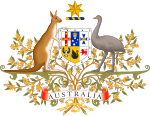| New South Wales v Commonwealth | |
|---|---|
 | |
| Court | High Court of Australia |
| Full case name | New South Wales & Ors v Commonwealth |
| Decided | 14 November 2006 |
| Citations | [2006] HCA 52, 229 CLR 1 |
| Transcripts | Day 1 [2006] HCATrans 215 Day 2 [2006] HCATrans 216 Day 3 [2006] HCATrans 217 Day 4 [2006] HCATrans 218 Day 5 [2006] HCATrans 233 Day 6 [2006] HCATrans 235 |
| Court membership | |
| Judges sitting | Gleeson CJ, Gummow, Kirby, Hayne, Callinan, Heydon & Crennan JJ |
| Case opinions | |
| Decision by | Gleeson CJ, Gummow, Hayne, Heydon and Crennan JJ (par. 1–422) |
| Dissent | Kirby J (par. 423–616) and Callinan J (par. 617–914) |
| Keywords | |
New South Wales v Commonwealth (also called the WorkChoices case)[1] is a landmark decision of the High Court of Australia, which held that the federal government's WorkChoices legislation[2] was a valid exercise of federal legislative power under the Constitution of Australia. In essence, the majority (Gleeson CJ, Gummow, Hayne, Heydon & Crennan JJ) found the Constitution's corporations power capable of sustaining the legislative framework, while the conciliation and arbitration and territories powers were also seen as supporting parts of the law. Furthermore, the majority also held that the legislation permissibly limited State powers and did not interfere with State constitutions or functioning. A minority (Kirby and Callinan JJ) dissented.
The case attracted considerable attention before, during and after the High Court decision was delivered on 14 November 2006. As a legal precedent, it may signify a shift in the distribution of power from the States to the Federal Parliament. Thus, the decision could well be regarded by historians of Australian federalism as an important legal landmark.
- ^ NSW v Commonwealth (WorkChoices case) [2006] HCA 52, (2006) 229 CLR 1, judgment summary (PDF), High Court
- ^ "Workplace Relations Amendment (Work Choices) Act 2005". Commonwealth of Australia. 12 December 2006.